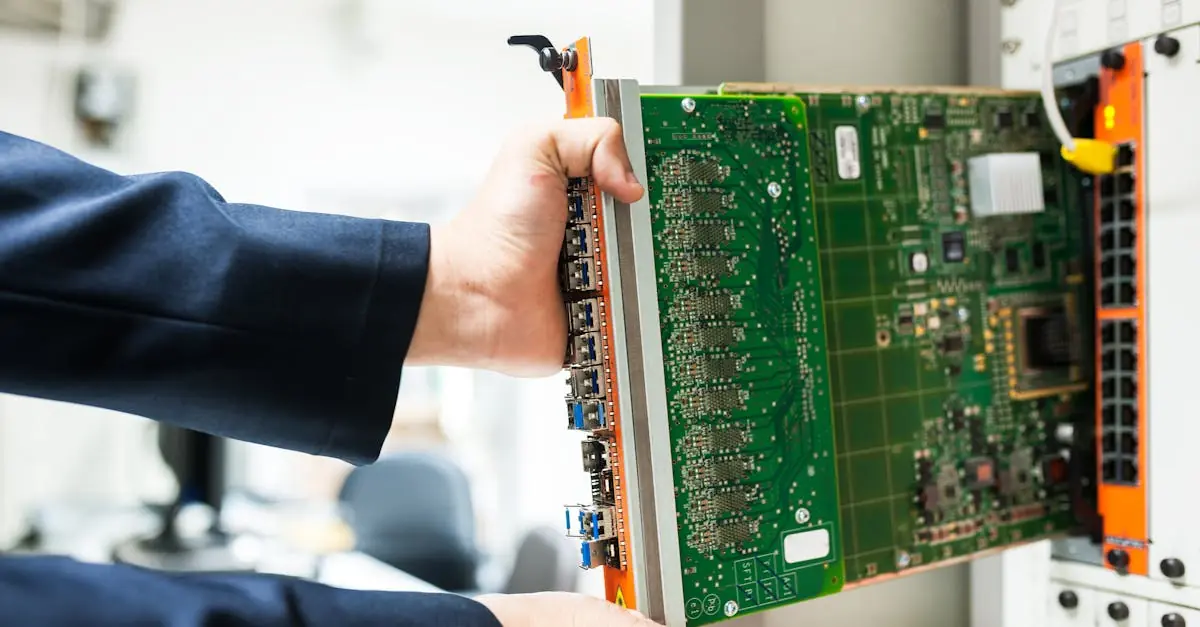In today’s digital age, a reliable internet connection is as essential as coffee on a Monday morning. Yet, many find themselves tangled in the mysterious world of router configuration, where the stakes are high and the Wi-Fi signal can be as elusive as a cat during bath time. Fear not! With a little guidance, anyone can conquer their router and unlock a seamless online experience.
Table of Contents
ToggleOverview of Router Configuration
Router configuration involves setting up the device to enable efficient network communication. Users configure various settings to optimize their internet speed and security. Common steps include accessing the router’s web interface, usually done through a web browser by entering the router’s IP address. Administrators typically log in using default credentials or custom usernames and passwords.
Settings to consider during configuration include wireless network names (SSIDs) and passwords. Choosing a unique SSID helps identify the network easily. Adjusting the password to a strong combination increases security against unauthorized access.
Additionally, users often adjust network channels to reduce interference from nearby routers. Selecting a less congested channel minimizes potential disruptions. DHCP settings also play a crucial role, as these determine how IP addresses are distributed within the network. Configuring static IP addresses for specific devices can also enhance connectivity for essential equipment.
Security configuration includes enabling WPA3 encryption. This encryption protocol offers robust protection. Firewalls within routers offer added security layers, blocking unwanted traffic and safeguarding connected devices.
For troubleshooting, users should look into firmware updates to maintain optimal performance. Regularly checking for updates ensures the router runs on the latest software, boosting efficiency and security. Monitoring network speed through performance tools can help identify any lags impacting connectivity.
Effective router configuration ensures a reliable connection. This leads to improved user experiences and fewer disruptions throughout the day.
Importance of Proper Router Configuration
Proper router configuration plays a crucial role in achieving a seamless online experience. A well-configured router not only enhances security but also boosts network performance.
Enhanced Security
Enhanced security is one of the primary benefits of proper router configuration. Configuring settings like WPA3 encryption protects personal data from unauthorized access. Firewalls offer another layer of defense against external threats. Regularly updating the router’s firmware closes potential security gaps. Assigning strong passwords to the Wi-Fi network decreases vulnerability to cyber intrusions. Minimizing risks through proper settings prevents issues before they arise. Using guest networks also keeps personal devices secure while allowing visitors limited access.
Improved Network Performance
Improved network performance results from precise router configurations. Adjusting wireless channels reduces interference from neighboring networks, leading to faster speeds. Static IP assignment for critical devices ensures stable connections, preventing disconnections. Optimizing Quality of Service (QoS) settings prioritizes bandwidth for essential applications, enhancing overall functionality. Regular monitoring of network performance allows users to identify and manage any issues proactively. Consequently, these configurations contribute to a more reliable and efficient internet experience.
Steps for Basic Router Configuration
Router configuration plays a vital role in ensuring a seamless internet experience. Following these steps simplifies the process for effective management of home networks.
Accessing the Router Interface
To access the router interface, connect a device to the router’s network. Typing in the router’s IP address, often found on the device or its manual, opens a login page. Enter the administrator credentials, typically set to default values unless changed by the user. Familiarizing oneself with the layout of the interface helps in navigating various options efficiently. Most routers provide detailed descriptions of each setting, making adjustments easier for users.
Configuring Network Settings
Configuring network settings involves adjusting essential parameters for optimal performance. Users should start by setting a unique network name (SSID) to easily identify the network. Changing the default password enhances security significantly. Adjusting DHCP settings enables automatic IP address allocation for connected devices, simplifying network management. Assigning static IP addresses to key devices ensures steady connectivity, preventing IP conflicts. A clear understanding of these settings is necessary for a reliable network.
Setting Up Wi-Fi
Setting up Wi-Fi requires inputting the SSID and choosing a secure password. Users should select WPA3 encryption if supported, as it offers robust protection against unauthorized access. Configuring channels to minimize interference involves selecting the least crowded frequency for operation. Moreover, enabling guest networks can offer access to visitors without compromising core network security. Regularly monitoring the Wi-Fi performance allows users to make further adjustments for maintaining speed and connectivity.
Advanced Router Configuration Options
Advanced router configuration options provide users with additional tools for optimizing network performance and security. These settings enhance the overall internet experience.
Quality of Service (QoS)
Quality of Service (QoS) prioritizes bandwidth allocation for specific applications and devices. Users can configure QoS settings to ensure that essential applications receive sufficient bandwidth. Gaming consoles, video streaming services, and VoIP applications benefit from this prioritization, reducing lag and improving overall performance. Administrators typically access their router’s QoS settings through the web interface, where they can define priorities based on device MAC addresses or applications. Users find that expressing these priorities leads to smoother online experiences, especially during peak usage times.
Firewall Settings
Firewall settings play a crucial role in protecting the network from unauthorized access. Users configure their router’s firewall to block malicious traffic while allowing legitimate communications. Most routers feature options for configuring basic and advanced firewall settings, including port filtering and access control lists. Adjusting these settings enhances security, creating a safer environment for connected devices. Users benefit from keeping these configurations up to date, as cyber threats evolve continually.
Port Forwarding
Port forwarding allows external devices to access specific services on the home network. Users employ this feature for applications like gaming servers or remote desktop services. By specifying which internal IP addresses and ports to forward, users enable smoother connections for external clients. Accessing the router’s port forwarding settings typically involves entering the device’s IP address and desired ports in the web interface. Users often find that effective port forwarding results in fewer connection issues and improved gameplay experiences.
Common Router Configuration Mistakes
Misconfiguring the SSID often leads to confusion. Users frequently stick with default names, increasing vulnerability. Changing the SSID to something unique enhances security while making networks easily identifiable.
Overlooking firmware updates is another common error. Outdated firmware can lead to security holes and performance issues. Regular updates protect against potential threats and improve functionality.
Neglecting to set strong passwords compromises the network’s integrity. Weak passwords make it easy for unauthorized users to gain access. Implementing complex passwords with a mix of letters, numbers, and symbols significantly boosts security.
Failing to adjust DHCP settings can create IP address conflicts. Automatic allocation of IPs often suffices, yet static IP assignments for crucial devices ensure seamless connectivity. Static assignments prevent potential disruptions for devices like printers or gaming consoles.
Forgetting to enable network encryption poses a risk. WPA2 or WPA3 encryption provides essential protection for data transmitted over the network. Enabling encryption safeguards personal information from cyber threats.
Ignoring network performance tuning leads to inefficiencies. Some users overlook Quality of Service settings that prioritize bandwidth for essential applications. Configuring QoS can enhance experiences for activities like streaming and gaming.
Lastly, overlooking guest network options can jeopardize primary network security. Enabling guest networks helps keep personal devices safe from visitors. This keeps the core network secure while providing internet access to guests.
Mastering router configuration is essential for anyone seeking a seamless internet experience. By following the outlined steps and implementing robust security measures users can significantly enhance both performance and safety. Regularly updating firmware and monitoring network activity further ensures a stable connection.
Proper configuration not only protects personal data but also optimizes bandwidth for critical applications. With the right approach even the most perplexing router settings can become manageable. Embracing these practices empowers users to take control of their home networks and enjoy reliable connectivity in today’s digital landscape.





